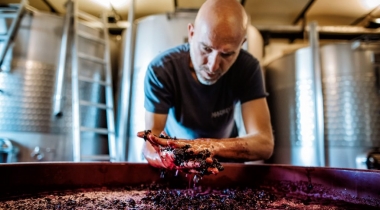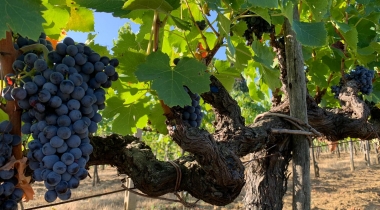Short excerpt from Gambero Rosso
>>> Read here on Gambero Rosso
IT’S ALWAYS BEEN CALLED GAMAY, WHEN IN REALITY IT’S GRENACHE… BUT IN FACT IT’S THE REPRESENTATIVE WINE OF LAKE TRASIMENO. FIERCE AND DETERMINED VINEYARDS HAVE TAKEN OVER THE HISTORY OF THIS WINE WITH DIFFERENT EXPRESSIONS AND POTENTIALS.
If making mistakes is human and persevering is diabolical, well, around here they’ve elevated the old adage to gospel. An entire paradigm was founded on an error, giving the keys to territorial identity to a “wrong” wine. We are talking about Gamay del Trasimeno which, immediately clearing any misunderstandings, Gamay is not. We are therefore not dealing with a half-brother of the typical vine of Beaujolais, but rather with the most cultivated grape in the world, Grenache, which has origins in Spain but today we find widespread in California, South Africa, Chile, Australia and in Sardinia with the name Cannonau and in Veneto with the name Tai Rosso (see article on the April 2018 issue of Gambero Rosso n.315, dedicated to this grape in Italy and in the world). We are in northern Umbria, in the Perugia province, between still waters and multiform skies, far from the glories of Sagrantino and close to Tuscany’s Cortona Syrah as well as to the noblest Sangiovese, so difficult to challenge on its own terrain (yet so many have attempted to).
Over the years, on these hills, Ciliegiolo, Grechetto and Trebbiano have found a home and excellent expression, as well as various international varieties, Merlot and Cabernet above all, even more comforted by the Bordeaux hangover of the 90s. But looking further back in time––viticulture here has very ancient origins––the episode that led to the false Gamay, traditionally planted as an alberello system and alas renamed “French viney,” speaks Spanish. A fascinating narrative that blends history and legend sees its first appearance as imported in the early 1600s by Eleonora Alarcòn y Mendoza, wife of Duke Fulvio della Corgna (family who ruled the marquisate, later duchy, of Castiglione del Lago). Lady Eleonora was an advocate of the good red wine the grape rendered: generous alcohol content, good structure, pleasant roundness, excellent aromatic intensity. The cataloguing was wrong, but by then known as Gamay locally, once the error was discovered, the general decision was to keep going on as always, aiming rather to select the local clone to make the most of it, and forging it as the spearhead of the Colli del Trasimeno DOC.
Madrevite, amid lakes and hillsides
The Madrevite cellar owes its name to an ancient utensil once used to close the small front opening of barrels. Located in Cimbano, on rolling hills dappled in forests and farmed fields, in the mild climate watched over by the lakes of Chiusi and Montepulciano, and by Lake Trasimeno. Nicola Chiucchiurlotto trampled these lands following his grandfather Zino, or driving alongside him on a tractor, at a time when agriculture meant sustenance, and cattle was raised alongside arable land, vegetable gardens, vineyards and olive groves. «At most, we contemplated a form of barter, and wine was nothing more than food. I still remember when I accompanied my grandfather to the ‘cantinone,’ from which folks returned with the dosages of tartaric and metabisulfite to make the wine more drinkable.» Nicola defines himself as proud and courageous, stubborn and a dreamer. It is certainly refreshing to be overwhelmed by one’s passion, by the energy he expresses when talking about his company. «I started studying agriculture, I worked in a neighboring winery alongside an expert oenologist, and that’s when I first fell in love with the profession.» He followed other paths, then enrolled in an evening course for winemakers, and it was a final study abroad program that marked the turning point: if his career in wine had seemed inaccessible when visiting the great Tuscan companies, he was he greatly encouraged by the spirit he met in France, where «one barrel and a garage» seemed enough to give voice to a terroir.
In 2003 the Madrevite brand was born, today 60 total hectares of which 11 are vineyards, in organic conversion «as a model of life, as a movement of conscience rather than certification.» Gamay was already here, in a splendid but exhausted vineyard at the top of a balcony, planted as alberello by Zino «with railroad cross pieces as head posts.» It was explanted «but 200 plants were saved in the adjacent vineyard, and from those we started again for the new grafts started in 2007.» Fatty, fertile clays that infuse plants and grapes with vigour, for a first bottle of rosé Gamay that materialised in 2009. And therefore once again lots of studying, research, work, assisted by oenologist Emiliano Falsini and agronomist Stefano Dini, thus forming a loyal group of collaborators. Until the debut of C’osa, understood as a product by those “who dare,” the first Gamay Riserva of the 2016 harvest, «a selection of grapes from now settled, adult vines, then aged in barrique,» a Gamay del Trasimeno with hints of rose and spices, warm and enveloping on the palate. «The need for a fresher and more immediate product has led us to add a vintage version,» hence Opra 2019, crisp and varietal, tasty to the last sip. Each label contains a proud gesture, in Madrevite, each grape is vinified in purity «so that all its qualities can be revealed, and the complexity of the territory that houses it can be expressed forming with it one thing.»
Estratto da un articolo a cura di Emiliano Gucci (Gambero Rosso)





